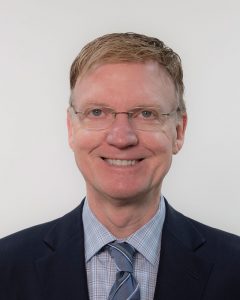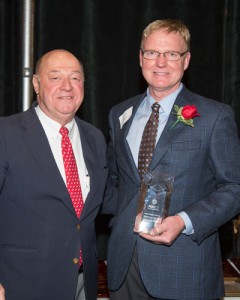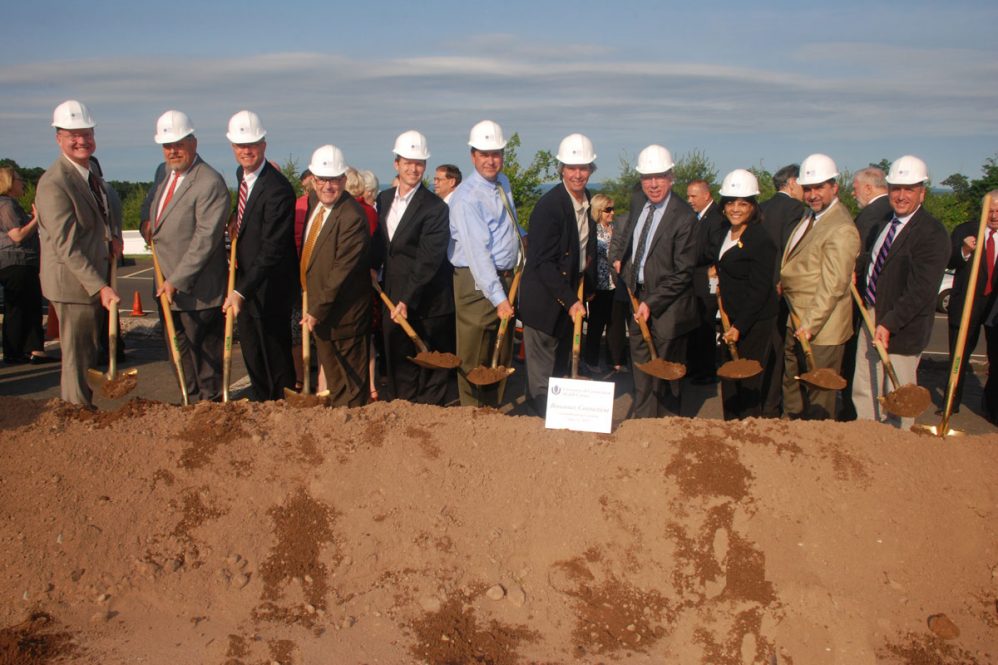There was a lot of attention given to the details and finishes to make the environment welcoming and promote healing. — Tom Trutter
Think of any campus improvement or construction project at UConn Health this century, and chances are Tom Trutter was involved in it — some combination of planning, managing, and overseeing.

Trutter is retiring from 28 years of full-time service to the University, including the last 20 years at UConn Health, where he became known as the go-to person for all things construction and campus planning.
More formally, he started as a university architect in Storrs in 1990. After two years he went to Yale as a project manager, then returned to UConn as a project manager in 1995. UConn Health hired him as director of capital projects in 2001. He would become the associate vice president for campus planning, then AVP for the combined Departments of Campus Planning and Facilities Management.
In 2012, ground broke on the first in a series of major construction projects on the UConn Health campus that would lead to, most notably, a new hospital tower, the Outpatient Pavilion, the academic rotunda, three new parking garages, and a modernization of research lab space. The capital projects were part of Bioscience Connecticut, a major state investment in health care and biomedical research infrastructure, and Trutter’s role was to oversee them. Upon their completion he became VP for facilities development and operations, the position from which he retires Nov. 30.
He agreed to an “exit interview” with UConn Today.
Describe what UConn Health was like when you first arrived compared to today?
I think this is one of those, “the more things change, the more things stay the same” stories. The focus has always been on our missions in research, education and clinical care. When I first started, there was a desire and drive, but perhaps not the resources, to grow and advance. Now I think financial and other resources are allowing UConn Health to excel and get better in all of these areas year after year.
Among the many changes to the UConn Health campus over your time here, what would you say is most significant?

What was accomplished in terms of new construction and renovations under the Bioscience Connecticut program has enabled UConn Health to accelerate and advance its core missions. I think we are now more visible, both literally and figuratively speaking, and we are seeing more recognition for the work that goes on in our buildings. At the end of the day, I am very proud of the way the campus now looks and to have had a hand in that is very gratifying. Also, I think that the physical environment that one works in, or receives care in, has a major impact and does affect results and outcomes. There was a lot of attention given to the details and finishes to make the environment welcoming and promote healing.
In more recent years, before the pandemic, one of your focuses was on sustainability efforts on campus. How is UConn Health’s progress in this area?
Leadership in Energy and Environmental Design (LEED) is a widely used “green building” rating system that recognizes sustainability achievements in construction. All of the major construction and renovation projects at UConn Health applied the LEED criteria that measures the mitigation of environmental impacts of construction and building of the life cycle of a building. This, along with recycling, energy conservation, transportation management, all comprise a comprehensive sustainability program. We continue to make strides in this area and there is more to do, but the efforts are making a difference and lowering our environmental impact.
How did the pandemic impact your and your staff’s work?
Like many areas, the facilities management staff are essential workers, so they have been here every day to make sure the buildings are safe for our patients and staff. I am grateful for the dedication of the staff and proud of how everyone stepped up and responded to the ever changing needs. It was a very dynamic situation with the need to change air flows and pressures on the hospital floors in order to isolate certain areas.
What’s something many probably don’t realize about the work of facilities development, operations, or campus planning?
I think that it is hard to realize how complex our buildings are. They are complex to renovate, usually requiring many phases, and they are complex in terms of building mechanical, electrical, plumbing, and life safety systems (fire alarm, sprinklers, emergency power, etc.). The operations and daily maintenance is 24/7 and is extremely important. Lives literally depend on all the systems working properly. We are fortunate to have skilled staff who understand the systems and how to operate and maintain them.
What will you miss most about UConn Health?
I will miss being part of the teams that work to grow and improve UConn Health. Be it the senior leadership team, the teams within my department, or the interdepartmental teams such as life safety, they all have been rewarding to be part of.
What can you share with the UConn Health community about your plans in retirement?
I will be a reemployed retiree for a bit so not fully gone just yet. I will be working on special projects and still providing support in my department until my position is re-filled.
After that, my wife, Becky, and I plan to “grow bolder” (this is a reference to a CPTV show called “Growing Bolder”) by traveling and exploring new ways to give back to our community and the organizations we care about. I am looking forward to the opportunities that will be available to me because of the new found free time. We are not moving and we plan to stay in Connecticut, at least for now.



